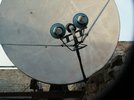Vipersan
Emmett Browns Ghost
- Joined
- Jun 29, 2009
- Messages
- 10,918
- Reaction score
- 6,663
- Points
- 113
- Age
- 67
- My Satellite Setup
-
IP9000HD +
TD110 Dish and TD88 Dish in Tandem
66°East to 60°West.
AZbox PrmHD + OpnbxS9HD + Skybox + DrHD F15
2x VboxII AZ-EL
2 m+ Alcoa PF + BSC421 C-Band lnbf...
+SS2/TwHnS2-3200 pci/TBS6925 pci
1.5 Fortec Star -Gbox - HtoH Ku/Ka/C
- My Location
- UK
I totally agree Paul ..
Of course it depends on you definition of 'massive dish'
As is well documented in this forum ..
I have little or no trouble getting decent cband signals from 55 and 58West on my 1.8 pf
And would therefore assume it would even be possible to pull some of the stronger transponders such as Bolivia TV (55W) on a 1.2m dish
Paul is also right in saying the Harder ...at least for me...C band birds lie on the Eastern half of the Arc ..
And so far the furthest East Cband channel I've picked up is a 'WinnersTV' feed on 62 East ...
Sadly encrypted so I can't even post a photo.
rgds
VS
I think I should clarify and qualify what I wrote ...
The most important thing is clear unobstructed views relatively low on the Horizon both East and West ..
If this is possible ...then Cband on a 'relatively ' small dish should be possible providing care is taken to optimise setup & reception...
..and a good quality Low K lnb does make a huge difference of course..
;)
Of course it depends on you definition of 'massive dish'
As is well documented in this forum ..
I have little or no trouble getting decent cband signals from 55 and 58West on my 1.8 pf
And would therefore assume it would even be possible to pull some of the stronger transponders such as Bolivia TV (55W) on a 1.2m dish
Paul is also right in saying the Harder ...at least for me...C band birds lie on the Eastern half of the Arc ..
And so far the furthest East Cband channel I've picked up is a 'WinnersTV' feed on 62 East ...
Sadly encrypted so I can't even post a photo.
rgds
VS
I think I should clarify and qualify what I wrote ...
The most important thing is clear unobstructed views relatively low on the Horizon both East and West ..
If this is possible ...then Cband on a 'relatively ' small dish should be possible providing care is taken to optimise setup & reception...
..and a good quality Low K lnb does make a huge difference of course..
;)

